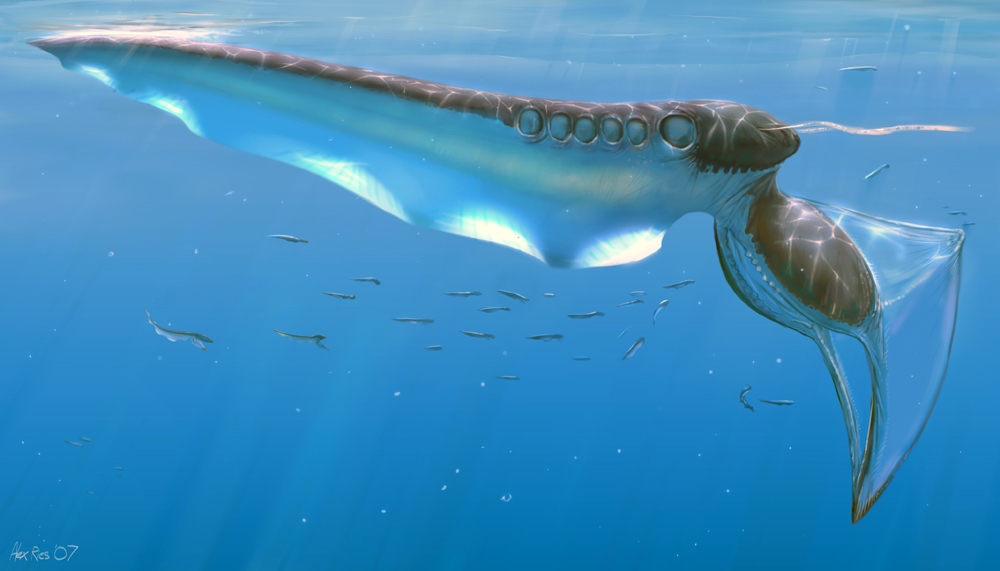Zoology
Cattel of the Fluid Nations: Barnard's SwallowerNOTE: The images and ideas presented here are copyright Alex Ries and based on his Barnard's Swordswallower concept, except for material previously posted in the Endless Blue campaign setting blog. The use Alex's work here is not meant as an infringement of those rights, and is used without permission. It does not qualify as Open Game Content as per the OGC document. If you enjoyed what you have read/seen here, please visit Alex's website at http://www.alexries.com, his blog at http://exozoo.blogspot.com, and his DeviantArt page at http://abiogenisis.deviantart.com.
Barnard's Swallower
Gargantuan Aberration (Aquatic)
Hit Dice: 4d8 +4 (22 hp)
Initiative:
Speed: 20 feet (4 cubes)
Buoyancy: Shoals (adjustable)
Armor Class: +1
Base Attack/Grapple: -3/+13
Attack: Water Slap (1d8 points of subdual damage)
Full Attack: Water Slap (1d8 points of subdual damage)
Space/Reach: 40 ft./5 ft.
Special Attacks: Net
Special Qualities: None
Saves: Fort +1, Ref +2, Will +4.
Abilities: Str 10, Dex 12, Con 13, Int 2, Wis 9, Cha 8
Skills: Hide -5, Search +7, Spot +7, Survival +7
Feats: Improved Grab, Improved Natural Armor, Snatch, Tracescent
Environment: Temperate, open waters (Shoals)
Organization: Solitary or mating pairs.
Challenge Rating: 1/2
Treasure: None, other than body parts.
Alignment: Always neutral.
Advancement: Young (1HD), Juvenile (2-3 HD), Adult (4 HD)
Level Adjustment: -
Hit Dice: 4d8 +4 (22 hp)
Initiative:
Speed: 20 feet (4 cubes)
Buoyancy: Shoals (adjustable)
Armor Class: +1
Base Attack/Grapple: -3/+13
Attack: Water Slap (1d8 points of subdual damage)
Full Attack: Water Slap (1d8 points of subdual damage)
Space/Reach: 40 ft./5 ft.
Special Attacks: Net
Special Qualities: None
Saves: Fort +1, Ref +2, Will +4.
Abilities: Str 10, Dex 12, Con 13, Int 2, Wis 9, Cha 8
Skills: Hide -5, Search +7, Spot +7, Survival +7
Feats: Improved Grab, Improved Natural Armor, Snatch, Tracescent
Environment: Temperate, open waters (Shoals)
Organization: Solitary or mating pairs.
Challenge Rating: 1/2
Treasure: None, other than body parts.
Alignment: Always neutral.
Advancement: Young (1HD), Juvenile (2-3 HD), Adult (4 HD)
Level Adjustment: -
Approximately 40 feet long from tip of sail to end of net, the Swallower is most notable for its distinctive knife-shape trunk and crop. The trunk has about the same degree of flexibility as that of a Mer's spine, and trails a ventral fin from tip to neck. Its epidermis is a blubbery, resilient skin that is a mottled slate grey along the dorsal side and a pale bluish-white along the belly. A series of six paired openings along the trunk are the gills of the beast.
Swallowers are hermaphoditic, with a reproductive system that both provides and receives genetic material. When the mating season begins, swallowers congregate in wide, open waters and release their seed packets into the currents where hopefully another swallower will swim through the plume of sperm and collect enough to become impregnated. Self-impregnation seems to be biologically impossible due to the creature's own immune system. But it is expressly due to this "pollination" method of reproduction that piscean selection could begin the animals' slow alteration from wild beast to domesticated livestock.
Combat
The swallower is a docile beast, slow to move and relatively weak despite its size. It makes a poor beast of burden; instead its value to piscean settlements is as livestock.
The ventral fin acts in many ways like a keel, and undulates in a rippling wave to produce forward momentum, much like the fins on the side of a squid. Normally the eddies created in the currents from this motion would scatter prey in proximity, but the swallower developed a hunting skill to account for this -- it will snap the fin in a strong, sharp swat, effectively smacking small prey with a wall of water. While their senses are overloaded from the impact of the water, the swallower can scoop them up in its net. Few so buffeted can collect their wits again before they are engulfed. Their main diet is comprised of great gulps of plankton that are easily found in the blooming open waters of Elqua, supplemented by the occasional small fish or other animal unfortunate enough to be caught in the Swallower's uniquely evolved digestive system.
The bulbous portion hanging down from the "blade" is the animal's digestive system, which parts open in much the same way a bivalve clamshell does. When it does open, it releases a sheer, billowing "net" anchored to thin limb-like protrusions. This fine fibered netting is organic in nature -- a silk derived from glands lining the Swallower's bulb -- and is used as a sieve to filter the animal's preferred meal stock from the ocean's currents: plankton. Much like the massive whales, the gargantuan Swallower is dependent on one of the tiniest species of life for its continued survival.
Living creatures are pushed into this organic colander due to the disruptive currents of the Swallowers fin, where they are caught against the slime covered net. This mucus is constantly being secreted while the net is inside the Swallower's bulb, and is slightly acidic due to the collection of enzymes that give it the tacky qualities that trap its prey. As the chemical reactions from the enzymes break down the trapped food, it sloughs down the netting in the form of a nutrient rich nectar, perfectly prepared for digestion.
When the net is closed again, the joint seen at the back of the Swallower bends under the bulb. There the briny bouillabaisse pools over what constitutes the creatures actual mouth. An esophageal tube runs back up the back of the Swallower's net limbs, carrying the pre-digested catch to the stomach proper. The connective netting between the folding limbs is a natural forming silk, that allows water to strain through the membrane but keep its plankton catch intact. The enzymic acid it excretes to dissolve its prey also wears away at this silk, so the netting is in a constant state of repair.
The Swallower's net grab does not inflict damage. Instead, it slowly excrete enzymes that kill prey collected in its net. Treat the enzyme as an Acid. It can Snatch Large or smaller creatures in its net.
Despite it grand size, the Swallower has an easily mappable circulatory system. A series of veins and arteries transport the blood over the animal's body by means of small sac-like organs at the base of each gill. These are primitive hearts, muscular pumps providing the pressure to move blood to needy organs. Exhausted blood is circulated through the gills by means of small vascular loops. Due to its lethargic lifestyle, the ponderous beast lacks a powerful central heart like pisceans possess, and as a result over-stimulation has been known to make the creatures faint. This makes them easy prey in the wild.
The neural network of a Swallower is unsurprisingly primitive. It is of no revelation that the animal has never demonstrated any form of higher thinking skills, despite the best efforts of numerous packbreeders to create a better, smarter Swallower. At best the nervous system can essentially maintain the creature's autonomic systems functioning. The most complex thought processes the animal can achieve is feeding and movement, and not always at the same time. It accomplishes nature's evolutionary requirements, and nothing more, spurring the piscean phrase "dumb as a swallower" for anyone or thing that barely functions above a comatose state.
The intent of selectively breeding Swallowers has results in various fields. Resources scavenged from a Swallower are: enzymes for alchemists, silk for weavers, skin for tanning, even meat for eating.
Rumor has it that a tribe of Locanth nomads has begun a concerted effort to re-introduce the Swallower to the wild. Their packbreeders are attempting to breed self-reliance and animal instinct back into the creatures in order to restore the previously wild version to the shoals of the Gulf of Locanth.
"It is easier to ask for forgiveness than for permission, but seldom is it less risky..."
-- Sensate rationalization for many of their indulgences.
-- Sensate rationalization for many of their indulgences.











No comments:
Post a Comment